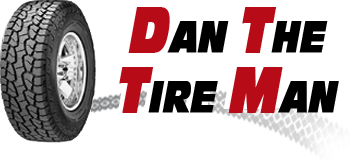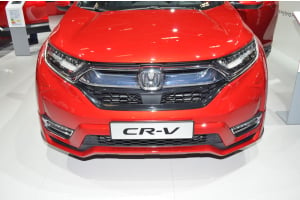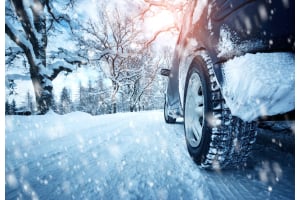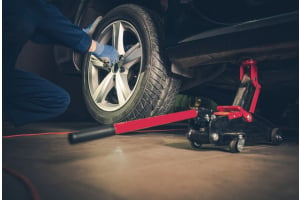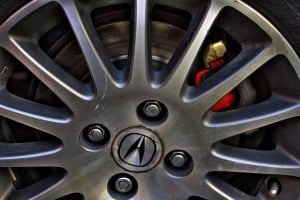Wheel Offset Explained Plus a Guide to Helping You Find It

If you’re looking at new wheels and tires — especially for a truck or SUV — you’ll see a term come up over and over:
Wheel Offset.
It’s one of the most important measurements when choosing wheels that fit properly, look the way you want, and don’t rub on your fenders or suspension. Offset determines how far your wheels stick out or tuck in, and it plays a big part in:
- Handling and steering feel
- Tire and fender clearance
- Wheel well appearance (flush, tucked, or “wide stance”)
- Suspension and brake component clearance
- Whether your tires rub when turning or hitting bumps
If your wheel offset is wrong, you’ll know it — either by rubbing, poor handling, or the wheels just looking off. But once you understand what offset is, choosing the right wheels becomes simple.
Let’s break it down in plain English.
What Exactly Is Wheel Offset?
Wheel offset is the distance between the centerline of the wheel and the surface that mounts to the hub (the mounting pad). That measurement affects where the wheel sits in the wheel well — either closer to the truck or pushed outward.
Offset is measured in millimeters (mm) and labeled as:
- Positive Offset (+)
- Negative Offset (–)
- Zero Offset (0)
Positive Offset (+)
The mounting surface is closer to the outside of the wheel, pushing the wheel inward toward the suspension.
Most modern trucks and SUVs come stock with positive offset.
- More tucked-in look
- Good for fuel economy and factory handling
- Can look narrow with bigger tires
Negative Offset (–)
The mounting surface is closer to the inside of the wheel, pushing the wheel outward. This creates a wider stance and is common on:
- Lifted trucks
- Off-road builds
- Wide stance street trucks
It gives a more aggressive look — but too much negative offset can cause rubbing or paint chips from road spray.
Zero Offset (0)
The mounting surface sits exactly in the center of the wheel width. This is common in certain off-road and aftermarket setups.
Why Wheel Offset Matters
Wheel offset isn’t just about appearance — it affects how your vehicle drives and what your tires touch inside and outside the wheel well.
Offset Affects:
| Vehicle Feature | How Offset Changes It |
| Stance / Style | Negative = wide look; Positive = tucked look |
| Handling | Too negative = loose steering; Too positive = tight/harsh steering |
| Clearance | Wrong offset can cause rubbing on fenders or suspension |
| Tire Wear | Incorrect offset can cause uneven or premature wear |
| Wheel Bearing Load | Extreme offset increases stress on suspension components |
Getting offset right means the wheels look great and drive correctly.
ET Numbers = Offset (Same Thing)
Some wheels use ET instead of the +/– notation.
- ET +20 = +20 mm offset
- ET 0 = zero offset
- ET -44 = -44 mm offset
So if you see ET on a wheel, that’s just offset in metric form.
How to Find Your Current Wheel Offset
There are a few easy ways to find the offset your vehicle currently uses:
1. Check Your Stock Wheels
Most OEM wheels have the offset stamped on the back of the spokes or hub surface. Look for something like:
+24
+30
+48
ET35
ET55
2. Check Your Vehicle’s Fitment Chart
We can look this up for you instantly — just contact us with your year/make/model. (Seriously — we do this all day and it takes us about 20 seconds.)
3. Measure Manually (If Necessary)
If you’re running unknown aftermarket wheels, you can measure:
- Measure the total width of the wheel (not the tire).
- Divide that width by two to get the centerline.
- Measure from the wheel mounting surface to the outer bead.
- Subtract the centerline from that number.
- Convert inches to mm (1 inch = 25.4 mm).
This gives you your offset value.
How Offset Affects Wheel Appearance
Here’s the part most people care about — how it looks.
| Offset Type | Look | Common Use |
| +40 to +18 | Factory / stock look | Daily-driving trucks & SUVs |
| +18 to 0 | Slightly aggressive, more flush | Light off-road or leveled trucks |
| 0 to –24 | Wheels start to stick out | Lifted trucks and show trucks |
| –24 to –44 | Deep dish, wide stance | Off-road, show builds, stance trucks |
The right offset depends on your suspension setup:
- Stock suspension → usually needs mild positive offset
- Leveled trucks → can run mildly aggressive offset
- Lifted trucks → can usually handle more negative offset
If you’re lifted or leveled and aren’t sure what offset is safe — we will gladly walk you through it specific to your lift height.
Offset + Wheel Width = The Full Picture
Offset alone doesn’t determine stance — wheel width matters just as much. Example:
| Wheel Size | Offset | Result |
| 20x9 +20 | Slightly outward from stock | Subtle clean look |
| 20x10 -18 | Noticeably wider stance | Aggressive but still practical |
| 20x12 -44 | Deep dish, sticks out significantly | Show truck territory |
Rule of Thumb:
When you go wider, the offset usually needs to become more negative.
Will a Different Offset Cause Rubbing?
Maybe — it depends on:
- Tire size
- Wheel width
- Suspension height
- Fender shape
- How much steering angle your vehicle has
Here are signs your offset may be too aggressive:
- Tires rub when turning full-lock
- Tires hit the fender when you go over bumps
- Mud flings up the side of the truck constantly
- Steering feels “floaty” or wanders on the highway
If we help match your wheel offset, we can prevent 99% of rubbing issues before you buy.
How to Choose the Best Offset for Your Setup
Here’s a basic guide:
For Stock Trucks
- Stay close to +18 to +40
- Keeps handling tight, no rubbing
For Leveled Trucks
- 0 to +18 is usually ideal
- Allows a slightly wider tire
For Lifted Trucks
- 0 to –44 depending on lift height and wheel width
- Negative offset gives the wide stance most people want
For Off-Road Use
- Aim for 0 to –24 to improve stability on uneven terrain
For Show Trucks
- Go –24 to –44 for deep-dish or wide-stance looks
- (Just keep in mind paint chips happen)
Quick Visual Reference
More Positive Offset → Wheels Tuck Inward
More Negative Offset → Wheels Push Outward
How We Make This Easy at DanTheTireMan.com
We know offset can be confusing when you’re comparing wheels online. So we simplify it:
- Tell us your truck / SUV
- Tell us whether it’s stock, leveled, or lifted
- Tell us the look you want: stock / flush / wide stance
And we will show you only wheels that fit and look right.
No guessing. No rubbing surprises. No returns.
Plus:
$0–$49 Down, No Hard Credit Check
We specialize in lease-to-own tire and wheel packages, even for customers with bad credit or no credit.
You choose the wheels → We ship them to your door → You make low payments.
We’ve been doing this since 2015 and we’ve helped thousands of customers get the wheels and tires they actually want — not just what they can afford up front.
Final Thoughts
Wheel offset is one of the key measurements that determines whether your wheels fit properly, avoid rubbing, and give your truck or SUV the stance and look you’re after. Once you understand how offset works — + vs. 0 vs. – — finding wheels becomes much easier.
If you want:
- Stock look → choose positive offset
- Clean flush look → choose mild offset (0 to +20)
- Wide stance → choose negative offset
And if you don’t want to think about any of it?
We’ll match it for you.
Just tell us your vehicle and setup.
Ready to Shop Wheels?
Visit: https://danthetireman.com/
Or message us and we’ll walk you through the perfect fit.
Dan The Tire Man
$0–$49 down • No hard credit check • Easy approvals • Free shipping
